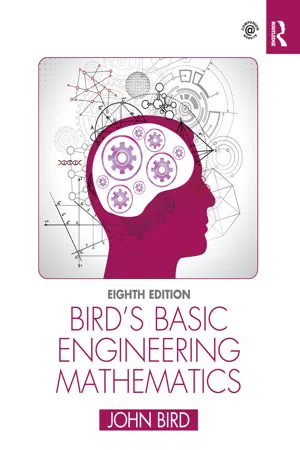Mathematics
Volume of Solid
The volume of a solid is the measure of the amount of space it occupies. In mathematics, it is typically calculated using formulas specific to the shape of the solid, such as the volume of a cube, cylinder, or sphere. Understanding volume is important for various applications, including geometry, physics, and engineering.
Written by Perlego with AI-assistance
Related key terms
4 Key excerpts on "Volume of Solid"
- eBook - ePub
- John Bird(Author)
- 2019(Publication Date)
- Routledge(Publisher)
Chapter 14 Volumes of common solidsWhy it is important to understand: Volumes of common solidsThere are many practical applications where volumes and surface areas of common solids are required. Examples include determining capacities of oil, water, petrol and fish tanks, ventilation shafts and cooling towers, determining volumes of blocks of metal, ball-bearings, boilers and buoys, and calculating the cubic metres of concrete needed for a path. Finding the surface areas of loudspeaker diaphragms and lampshades provide further practical examples. Understanding these calculations is essential for the many practical applications in engineering, construction, architecture and science.At the end of this chapter, you should be able to:- state the SI unit of volume
- calculate the volumes and surface areas of cuboids, cylinders, prisms, pyramids, cones and spheres
- appreciate that volumes of similar bodies are proportional to the cubes of the corresponding linear dimensions
14.1 Introduction
The volume of any solid is a measure of the space occupied by the solid. Volume is measured in cubic units such as mm3 , cm3 and m3 .This chapter deals with finding volumes of common solids; in engineering it is often important to be able to calculate volume or capacity, to estimate, say, the amount of liquid, such as water, oil or petrol, in differently shaped containers.A prism is a solid with a constant cross-section and with two ends parallel. The shape of the end is used to describe the prism. For example, there are rectangular prisms (called cuboids), triangular prisms and circular prisms (called cylinders).On completing this chapter you will be able to calculate the volumes and surface areas of rectangular and other prisms, cylinders, pyramids, cones and spheres. Volumes of similar shapes are also considered.14.2 Calculating volumes and surface areas of common solids
Science and Mathematics for Engineering. 978-0-367-20475-4, © John Bird. Published by Taylor & Francis. All rights reserved.14.2.1 Cuboid or rectangular prism
- eBook - ePub
- John Bird(Author)
- 2021(Publication Date)
- Routledge(Publisher)
Chapter 28Volumes and surface areas of common solids
Why it is important to understand: Volumes and surface areas of common solidsThere are many practical applications where volumes and surface areas of common solids are required. Examples include determining capacities of oil, water, petrol and fish tanks, ventilation shafts and cooling towers, determining volumes of blocks of metal, ball-bearings, boilers and buoys, and calculating the cubic metres of concrete needed for a path. Finding the surface areas of loudspeaker diaphragms and lampshades provide further practical examples. Understanding these calculations is essential for the many practical applications in engineering, construction, architecture and science.At the end of this chapter you should be able to:- state the SI unit of volume
- calculate the volumes and surface areas of cuboids, cylinders, prisms, pyramids, cones and spheres
- calculate volumes and surface areas of frusta of pyramids and cones
- appreciate that volumes of similar bodies are proportional to the cubes of the corresponding linear dimensions
28.1 Introduction
The volume of any solid is a measure of the space occupied by the solid. Volume is measured in cubic units such asandmm 3,cm 3m 3.This chapter deals with finding volumes of common solids; in engineering it is often important to be able to calculate volume or capacity to estimate, say, the amount of liquid, such as water, oil or petrol, in different shaped containers.A prism is a solid with a constant cross-section and with two ends parallel. The shape of the end is used to describe the prism. For example, there are rectangular prisms (called cuboids), triangular prisms and circular prisms (called cylinders).On completing this chapter you will be able to calculate the volumes and surface areas of rectangular and other prisms, cylinders, pyramids, cones and spheres, together with frusta of pyramids and cones. Volumes of similar shapes are also considered. - Richard Lehrer, Leona Schauble(Authors)
- 2023(Publication Date)
- Routledge(Publisher)
5 EXTENDING MOTION TO THREE DIMENSIONS Volume and Its MeasureDOI: 10.4324/9781003287476-5In typical elementary school mathematics curricula, learning about volume measurement is initiated by acquiring a formula for calculating the measure of right rectangular prisms: volume = length × width × height. Often, this approach fails to engage students’ conceptual understanding of volume because it requires only that students recall and execute a simple arithmetic procedure (Simon & Blume, 1994 ). Evidence suggests that approaches that emphasize volume calculation are less successful than those that foster a conceptual understanding of solid volume measurement (Huang & Wu, 2019 ). A conceptual grasp of volume is important so that students can extend volume measure beyond the traditional focus on rectangular prisms to include prisms with other bases and cylinders and other settings of volume measure where the familiar formula no longer applies. Moreover, as in other realms of spatial measure, it is critical to help students develop a theory of measure organized around core concepts and anchored in practical activity.Structuring and Dynamic Approaches to Volume Measure
Accordingly, mathematics education researchers have explored two general approaches to fostering students’ intuitions and emerging conceptions of volume. The first, extensively pursued by Battista, Clements, and colleagues (Barrett, Clements, & Sarama, 2017 ; Battista, 1990 , 1999 , 2004 , 2007 , 2012 ; Battista & Clements, 1996 , 1998 ; Clements, Swaminathan, Hannibal, & Sarama, 1999 ; O’Dell et al., 2017 ), supports students’ structuring of rectangular prisms and compositions of prisms as a lattice of unit cubes. This entails first enacting and eventually imagining completely filling 3-D structures with cubic units of a standard size and enumerating the cubes to obtain a measure of volume. Some (e.g., Panorkou, 2020 ) refer to this form of imagining as a packing or filling model, to reflect its emphasis on identifying the amount of substance that an object can hold. Battista and Clements (1996)- eBook - ePub
- Andre Castagna(Author)
- 2021(Publication Date)
- Barrons Educational Services(Publisher)
Many physical objects can be modeled using the basic solids discussed in this chapter. Some examples include:- Cylinders—trees, cans, barrels, people
- Spheres—balls, balloons, planets
- Prisms—bricks, boxes, aquariums, swimming pools, rooms, books
The dimensions needed for a solid figure can be found in the text of the problem. An added layer to these problems is that volumes or areas are used to calculate some other quantity. Some common relationships to look for include:- Mass = density × volume
- Total cost = cost per unit volume × volume
- Energy contained in a material = heat content × volume
For example, if a can has a volume of 100 cm3 and it is filled with a liquid whose density is 1.2 grams/cm3 , the mass of the liquid inside the can can be found:In some problems, a volume of material may be transferred from one container to another or transformed into another shape. In these cases, the total volume remains unchanged and the volumes before and after must be equal.Example 1
A cylindrical piece of metal has a radius of 15 in. and a height of 2 in. It goes through a hot-press machine that reduces the height of the cylinder to What is the new radius of the cylinder, assuming no material is lost? Round to the nearest thousandth.Solution: Strategy—Find the volume of the cylinder before pressing, and set it equal to the expression for the volume after pressing. Use this equation to solve for the radius after pressing.Example 2
An engineer for a construction company needs to calculate the total volume of a home that is under construction so the proper-sized heating and air conditioning equipment can be installed. The house is modeled as a rectangular prism with a triangular prism for the roof as shown in the accomanying figure. The roof is symmetric with EF = ED. The dimensions are AB = 30 ft, BC = 50 ft, and BD = 25 ft, and the measure of ∠EDF
Learn about this page
Index pages curate the most relevant extracts from our library of academic textbooks. They’ve been created using an in-house natural language model (NLM), each adding context and meaning to key research topics.



